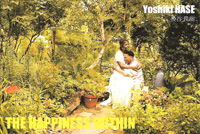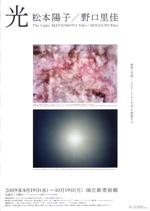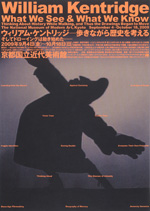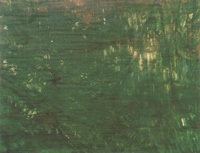 |
Picks is a monthly sampling of Japan's art scene, offering short reviews of exhibitions at museums and galleries in recent weeks, with an emphasis on contemporary art by young artists. |
 |
 |
 |
2 November 2009 |
 |
| 1 | 2 | |
 |
|
 |
 |
|
|
 |
 |
| Art Osaka 2009 |
| 21 - 23 August 2009 |
Dojima Hotel
(Osaka) |
 |
| Now in its third year, this all-hotel art fair, which turns the Dojima's guest rooms into galleries, has made some conspicuous improvements -- notably the inauguration of a Preview Day. Perhaps because of the ongoing recession, many of the works on display were of the small-scale variety. Sound thinking, no doubt, but one visitor was heard to murmur "this stuff wouldn't be considered museum-class by serious collectors." Tough times for the art business, indeed. |
|
|
 |
 |
 |
| Shiro to Kuro (Film Music by Toru Takemitsu) |
| 19 - 25 August 2009 |
Laputa Asagaya
(Tokyo) |
 |
| Shiro to Kuro (literally "White and Black," but best known as "Pressure of Guilt" in English) is a politically-tinged suspense film made by Hiromichi Horikawa in 1963. Screened at the quirky Laputa Theater in Asagaya as part of a retrospective of the film music of composer Toru Takemitsu, it features a cast of luminaries like Tatsuya Nakadai, Keiju Kobayashi and Nobuko Otowa, as well as cameos by writers Seicho Matsumoto and Soichi Oya. The stellar acting and bizarre twists and turns of the plot keep audiences entranced even today. |
|
|
|
|

|
 |
 |
 |
|
Yoshiki Hase: The Happiness Within |
| 15 - 29 August 2009 |
Gallery Yamaki Fine Art
(Hyogo) |
 |
| Hase shot these portraits of participants in an art therapy program in New York's East Village for people dealing with HIV or drug addiction. The photos are accompanied by poetry and other texts written by Hase's subjects. There is a sense of the time and patience required for trust to develop between photographer and subject that adds an extra depth to the images. |
|
|
 |
 |
|
|
Sharaku and Other Hidden Japanese Masterworks |
| 4 July - 6 September 2009 |
|
Edo-Tokyo Museum
(Tokyo) |
 |
| The rather arcane subtitle of this show, "From the Land of Nausicaa," refers to the fact that these works are on loan from the Museum of Asian Art on the island of Corfu, Greece. Collected by Gregorios Manos, Greek Ambassador to Japan a century ago, they were only recently discovered in the museum's collection. Of the 120 works on display, the centerpiece is a hitherto unknown fan painting by the elusive Ukiyo-e master Sharaku. Screen paintings from the Kano school and a variety of woodblock prints remind us of the richness of the urban merchant-class culture of the Edo Period.
|
|
|
|
|
|
|
|

|
 |
 |
 |
 |
| Yoko Matsumoto and Rika Noguchi: The Light |
| 19 August - 19 October 2009 |
The National Art Center, Tokyo
(Tokyo) |
 |
| Painter Matsumoto (b.1936) and photographer Noguchi (b.1971) belong to different generations and genres, but both share light as a central theme. At least, that is the museum's rationale for exhibiting their works concurrently. But since these are displayed in separate spaces and have utterly disparate styles, they might as well be billed as two different shows. Where Matsumoto's puffy motifs in various shades of pink evoke such popular images as cherries in full bloom, Noguchi works more abstractly, and often brilliantly, with the ephemeral characteristics of light itself.
|
|
|
 |
 |
| Takahiro Sagawa: Fuji Art Festival '09 |
| 1 - 6 September 2009 |
Gallery Haneusagi
(Kyoto) |
 |
| Sagawa is known for three-dimensional works that consist of large block letters. His latest project involved climbing Mt. Fuji with a sculpture of the letters tokihanate ("set free") on his back; this show chronicles the endeavor with video, photos and the work itself. Though the message may seem earnest, as Sagawa's usually do, the impression the sculpture gives is of irrepressible adolescent urges bursting forth. Its raw masculine power is, in fact, refreshing in this age of sexual ambiguity. |
|

|
 |
 |
 |
 |
|
| Iccho London and the Marunouchi Style |
| 3 September 2009 - 11 January 2010 |
Mitsubishi Ichigokan Museum
(Tokyo) |
 |
| This exhibition commemorates the completion of restoration work on the classic red-brick Mitsubishi Ichigokan, originally built in 1894 when the Marunouchi district of downtown Tokyo was known as Iccho London -- the London Block. The new museum will not open until April 2010, but meanwhile this show vividly documents how the samurai mansions of the Edo Shogunate gave way to the Western office buildings of the Meiji Era, of which the Ichigokan is one of the few survivors. Particularly compelling is a series of 500 photo portraits of the craftsmen and laborers who built it. |
|
|
|
|
 |
 |
 |
William Kentridge: What We See & What We Know
|
| 4 September - 18 October 2009 |
The National Museum of Modern Art, Kyoto
(Kyoto) |
 |
| This is the first large-scale exhibition in Japan of the work of South African artist Kentridge (b.1955, now based in Johannesburg). Two entire floors of the museum are devoted to 19 films and film installations, 36 drawings, and 63 prints from Kentridge's thirty-year career. Best known, perhaps, are his animation works, in which the primitive process of partial erasure and redrawing of charcoal and pastel drawings contrasts with the intense and profound content, which ranges from social and political concerns to fundamental questions of human existence. |
|
|
|
|
|
|
 |
 |
| Mai Tamano: fade away |
| 7 - 19 September 2009 |
Port Gallery T
(Osaka) |
 |
| Since childhood, photographer Tamano says, she has been unable to throw anything away. She finally decided to start photographing the items she had accumulated, a process culminating in this exhibition. Ten works are displayed on the wall and another forty in files -- just a drop in the bucket of the artist's collection, apparently, but full of surprises nonetheless. Her technique is orthodox, but the subject matter is decidedly original. |
|
 |
 |
 |
| Yasue Kodama: Shin-in (Deep Tone) |
| 7 - 19 September 2009 |
O Gallery eyes
(Osaka) |
 |
| Painter Kodama has lately moved in a more figurative direction, with the woods around her home as a motif. While her work never stops at mere reproduction of landscapes and her colors often seem to reverse negative and positive values, this new work is notable for being even more representational. The predominant color is green, but Kodama is clearly not concerned simply with replicating forest scenery, but with the smells, sounds, and other sensations one experiences only by forging deeper into those woods. |
|
|
|
|
 |
|